But she doesn't live in Paris, she lives in Crete. Can she make these little parcels in her Cretan kitchen?
Yes, of course she can! The ingredients, although not exactly the same, are all available locally:
4 escalopes de veau (these need a bit of explanation - see below)
4 petite tranches de jambon (I bought some good quality Greek low-fat ham slices)
4 tranches d'emmenthal (I used Cretan graviera - of course!)
50g de lard (i decided against using both bacon and ham in a beef dish - it's overly decadent)
2 cas de pignons ("OK, you don't really need to add those, do you?" said Mr OC - I omitted the pinenuts in the filling in deference to his culinary wishes)
2 cas de parmesan (we buy freshly grated parmesan on a regular basis, but freshly grated graviera will also do)
3 cas soupe de persil hache (I used the last of this season's parsley from our garden)
ail en poudre (no thanks, fresh garlic is just as good, very finely minced)
sel, poivre (there's nothing better than local sea salt and freshly ground pepper)
huile (extra virgin, our own production!)
concentre de tomates (last summer's tomatoes in season, their taste and freshness perfectly sealed in my home-made bottled sauce)
30cl du vin blanc (no blanc in the house today; my late father's rose production will have to do)
Greek beef is usually tough and chewy, and generally speaking, it is never seen in thin slices in Cretan butcher's displays. Not only that, but it never looks as though it has been hung to dry - it is usually overly fresh, its juices glistening. For this reason, I had to do some careful planning in order to secure the kind of meat cuts I wanted. I could have bought French beef at Marinopoulos, a French supermarket chain, but there is the problem of the beef cuts: you cannot confide in a supermarket assistant at the meat counter to take the time to prepare a cut of meat the way you want it.
I went to my friendly butcher in the main Agora of Hania; it's important to be on friendly terms with your butcher, to be able to explicitly state what you want, if you want anything out of the Cretan idea of ordinary (which is very restricted), and my order was definitely out of the ordinary. When I explained it to him, he gave me a knowing look, and told me that he had some German customers who ordered their meat just like that...
I chose a huge chunk of fat-less meat in his display case, and asked him to VERY THINLY SLICE six pieces, each one the size of my palm.To my dismay, I watched in horror as he cut the beef in thick slices. He stopped at the third slice. Then he got out a clean plastic carrier bag (the kind found in the supermarket), cut it on both sides to unfold it, and placed a slice in the middle of the sheet. Then he started pounding the meat with a mallet, and he didn't stop until that thick palm-sized slice of beef covered the whole sheet of plastic:
Each piece of beef yielded six strips of meat, just the right size for the paupiettes; I used only two of the three pieces of meat (and made 12 little roll-ups). The rest of the recipe was child's play: in fact, my kids helped me assemble them, by watching the video. I preferred the toothpicks instead of the string parcels, simply because it was easier to handle: here are my works of art:
Cooking the paupiettes was simple; they had to be nicely browned on all sides. The process for making the sauce was quite different to what I'm used to in Greek cooking, but the video made it easy to follow. The important step in the Cretan version of paupiettes de veau is to cook them long enough to make sure the meat would be soft and not chewy. To do this, once the paupiettes are added to the tomato sauce, single out one of the paupiettes, and prod it with a fork every now and then when checking on the cooking progress (it will need longer than 30 minutes when using Greek beef). While they continue cooking, make sure there is enough liquid in the pan so that the paupiettes don't stick to the bottom of the pan if they are going to get a longer-than-French-usual cooking time: try adding 3-4 tablespoons of water at a time, and no more. When you're satisfied that the meat has been cooked to tenderness, you can safely turn off the heat.
The paupiettes at the Chartier weren't cooked in tomato sauce, which is where I suppose the 'a l'italienne' bit comes in; I preferred the lighter Chartier sauce than the saucy tomato version that I made, but the latter fits better into the Greek cooking style: Mr OC was very pleased with the outcome.
The paupiettes at the Chartier weren't cooked in tomato sauce, which is where I suppose the 'a l'italienne' bit comes in; I preferred the lighter Chartier sauce than the saucy tomato version that I made, but the latter fits better into the Greek cooking style: Mr OC was very pleased with the outcome.
The paupiettes can be made in stages: I prepared them overnight and left them to soak in a little wine before cooking them the next day. They go well with a fresh green salad and some freshly fried or roast potatoes. A friend of mine suggested that they could also be filled with vegetables instead of ham, like for example slices of aubergine, zucchini or mushroom, as a healthier alternative.
Paupiettes de veau avec pommes de terre persillees et salade au chou: this meal did not yield many leftovers!
It's not hard to bring a little bit of Paris into my Cretan kitchen; I love cooking French food with Cretan ingredients - they adapt to it so well. But I will admit to a couple of things: Firstly, the texture of the Cretan beef was not the same as what I was eating in Paris; it was less fibrous and more tender there, even though the meat was not necessarily 'French beef' per se (the Chartier uses both local and imported meat). My paupiette sauce was not clear (as in Paris) or creamy (as in the video); the beef had been beaten so much to tenderise it, that it left finely minced bits in the sauce, making it thicker and grittier.Paupiette de veau on a bed of pilafi
Secondly, once olive oil is used in the place of butter in a French recipe, it changes the taste to the point that the meal becomes very Mediterranean rather than French. But it's also very hard for the average Cretan cook to charge ahead with the butter instead of making a grab for the olive oil canister, especially when so much liquid gold is available!
But one thing is the same: Bon appetit = Καλή όρεξη (Kali orexi)!
©All Rights Reserved/Organically cooked. No part of this blog may be reproduced and/or copied by any means without prior consent from Maria Verivaki.
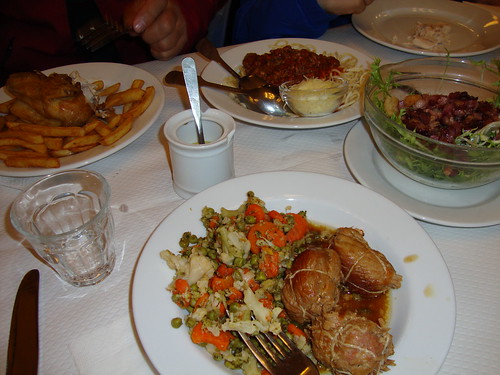
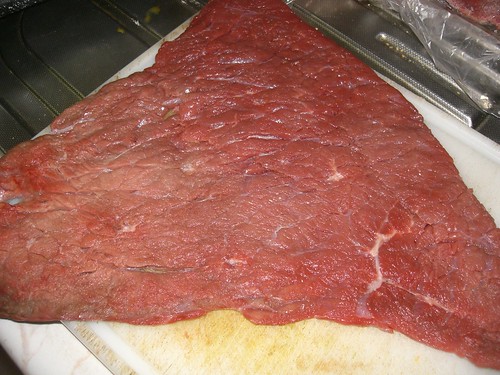

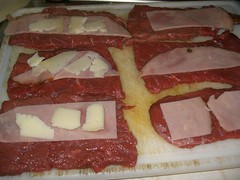
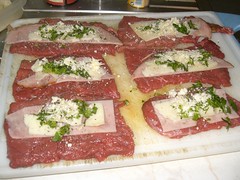
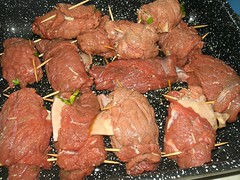
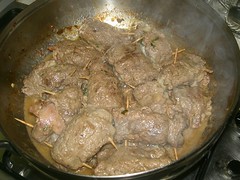
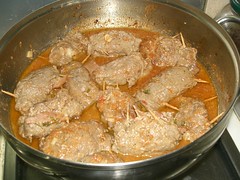
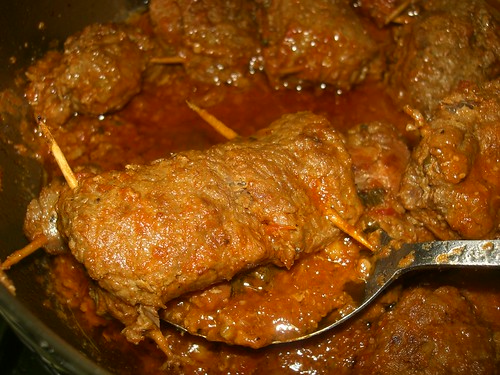
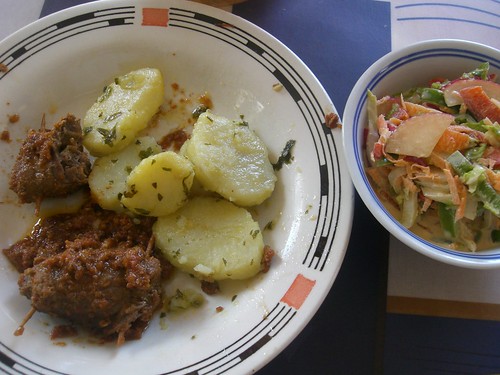
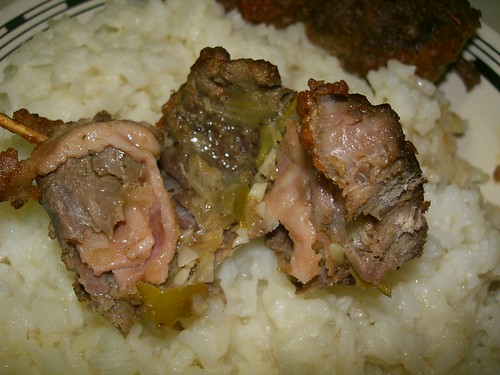
I am sure this dish was enjoyed by the whole family Maria. I like the fact that you used what is available as we do as well.
ReplyDeleteΠω, πω, φαίνονται πεντανόστιμα! Συγχαρητήρια Μαρία!
ReplyDeleteThis looks fantastic!!
ReplyDeleteMust try, must try!!
Maria, the paupiettes look amazing! I love how you cooked them in tomato sauce...I'm drooling!
ReplyDeleteThis reminds me of "veal birds" which have a bread stuffing. I think your recipe is nicer.
ReplyDeleteYour paupettes look beautiful Maria. Congratulations! Ah to be in France....
ReplyDeleteMagda
Mmmm, I'd love to have this for lunch today!! Bravo, I love how you adapted the ingredients - and to be honest, I like YOUR version much more!
ReplyDeleteInteresting post. Veal is coming back into fashion in the UK but not all the calves are caged. Is steak uncommon in Crete as I never tried or wanted any? How about ground steak - hamburger meat? How would you get that? Buy your own beef and then mince it? I like grass fed beef hung for at least 3 weeks and it is very common and easy to find in the UK. In the US a lot of beef is grain fed and on feed lots. What is the norm in Crete?
ReplyDeletebeef steak is not so popular in crete - our beef is simply too tough for that; it doesnt get that 3-week hanging period that english/french beef does (we basically buy it 3-4 days after the animal has been slaughtered which may sound absurd, but it's the truth!)
ReplyDeleteminced beef (ground steak) is very very popular - we use it a lot in our dishes - the butcher grinds it for you in your presence, even in the supermarket (at least here in hania this is the case)
i'm not quite sure where the beef is raised, but we dont have such a huge beef industry as in the US; there must be a bit of both going on here (outdoors and indoors) - they are fed on grain mainly